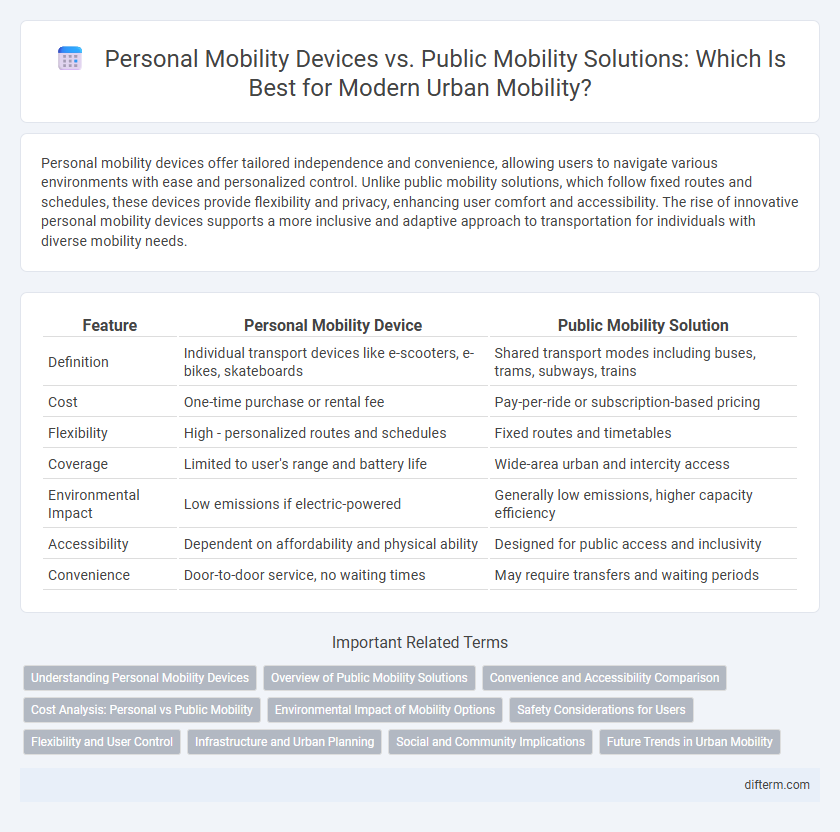Personal mobility devices offer tailored independence and convenience, allowing users to navigate various environments with ease and personalized control. Unlike public mobility solutions, which follow fixed routes and schedules, these devices provide flexibility and privacy, enhancing user comfort and accessibility. The rise of innovative personal mobility devices supports a more inclusive and adaptive approach to transportation for individuals with diverse mobility needs.
Table of Comparison
| Feature | Personal Mobility Device | Public Mobility Solution |
|---|---|---|
| Definition | Individual transport devices like e-scooters, e-bikes, skateboards | Shared transport modes including buses, trams, subways, trains |
| Cost | One-time purchase or rental fee | Pay-per-ride or subscription-based pricing |
| Flexibility | High - personalized routes and schedules | Fixed routes and timetables |
| Coverage | Limited to user's range and battery life | Wide-area urban and intercity access |
| Environmental Impact | Low emissions if electric-powered | Generally low emissions, higher capacity efficiency |
| Accessibility | Dependent on affordability and physical ability | Designed for public access and inclusivity |
| Convenience | Door-to-door service, no waiting times | May require transfers and waiting periods |
Understanding Personal Mobility Devices
Personal mobility devices such as electric scooters, e-bikes, and hoverboards offer users flexible and convenient transportation options for short distances. These devices enhance urban mobility by reducing reliance on public transit, decreasing traffic congestion, and lowering carbon emissions. Understanding the benefits and limitations of personal mobility devices is essential for integrating them effectively with public mobility solutions in smart city planning.
Overview of Public Mobility Solutions
Public mobility solutions encompass a variety of transport systems designed to serve large populations efficiently, including buses, subways, trams, and shared micro-mobility options like bike and scooter-sharing programs. These solutions reduce traffic congestion, lower emissions, and provide cost-effective transportation alternatives compared to personal mobility devices such as electric scooters or e-bikes. Integration of real-time data and smart infrastructure enhances service reliability and accessibility, promoting sustainable urban mobility across diverse demographic groups.
Convenience and Accessibility Comparison
Personal mobility devices like e-scooters and electric bikes offer unmatched convenience through flexible, door-to-door travel, minimizing wait times and route constraints common in public transit. Public mobility solutions, including buses and subways, provide extensive accessibility across urban areas, accommodating larger passenger volumes and ensuring affordability. Despite the ease of personal devices, public transit remains essential for inclusive mobility, especially in densely populated or low-income neighborhoods.
Cost Analysis: Personal vs Public Mobility
Personal mobility devices typically involve upfront costs such as purchase price, maintenance, and charging expenses, which can range from $500 to $3,000 depending on the model and features. Public mobility solutions, like buses and subways, operate on fare-based systems with monthly passes averaging $70 to $120, supported by extensive infrastructure and government subsidies that reduce individual financial burden. Cost analysis reveals that while personal devices offer flexibility and convenience, public mobility provides a more affordable and scalable option for daily commuting, especially in urban areas with high ridership.
Environmental Impact of Mobility Options
Personal mobility devices such as electric scooters and bikes significantly reduce carbon emissions compared to traditional vehicles by relying on clean electricity and promoting zero-emission travel. Public mobility solutions like buses and trains further minimize environmental impact through mass transit efficiency, reducing per capita energy consumption and lowering urban air pollution. Integrating both personal and public mobility options supports sustainable transportation systems that effectively decrease greenhouse gas emissions and traffic congestion in cities.
Safety Considerations for Users
Personal mobility devices such as electric scooters and e-bikes offer convenience but pose increased risks due to limited protective infrastructure and variable user experience. Public mobility solutions like buses and trains incorporate regulated safety measures, trained operators, and emergency protocols that significantly reduce user hazards. Effective safety considerations for users include helmet use, adherence to traffic rules, and awareness of vehicle maintenance standards to minimize accidents across both mobility modes.
Flexibility and User Control
Personal mobility devices offer unparalleled flexibility by allowing users to customize routes and travel times, enabling instant adjustments to meet personal schedules. These devices empower individuals with full control over their journey, reducing dependence on fixed public transport timetables and routes. Public mobility solutions, while efficient for mass transit, often limit user autonomy due to predetermined stops and schedules, making personal devices a more adaptable choice for spontaneous or unique travel needs.
Infrastructure and Urban Planning
Personal mobility devices require less dedicated infrastructure, offering flexibility and ease of integration into existing urban landscapes, reducing the need for extensive planning and high-cost investments. Public mobility solutions demand comprehensive infrastructure such as dedicated lanes, stations, and maintenance facilities, necessitating coordinated urban planning to optimize routes, accessibility, and safety. Effective urban planning balances these modalities by enhancing connectivity, minimizing congestion, and promoting sustainable mobility ecosystems that accommodate both private devices and public transit networks.
Social and Community Implications
Personal mobility devices promote individual autonomy and reduce reliance on congested public systems, fostering a culture of convenience but sometimes exacerbating urban clutter and safety concerns. Public mobility solutions encourage social interaction and equitable access across diverse communities, supporting environmental sustainability and collective well-being. Balancing private mobility device proliferation with robust public transit infrastructure is essential to maintain social cohesion and inclusive community development.
Future Trends in Urban Mobility
Personal mobility devices such as electric scooters and e-bikes are driving the rise of micro-mobility, offering flexible, last-mile connectivity that complements traditional public transit systems. Future urban mobility solutions prioritize integration of shared mobility platforms with real-time data analytics, enhancing efficiency and reducing congestion in dense city environments. Advances in autonomous vehicle technology and smart infrastructure connectivity are expected to synergize personal and public mobility, creating seamless multi-modal transportation networks.
personal mobility device vs public mobility solution Infographic

 difterm.com
difterm.com